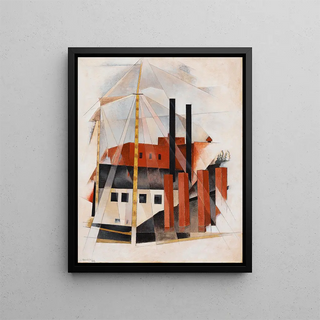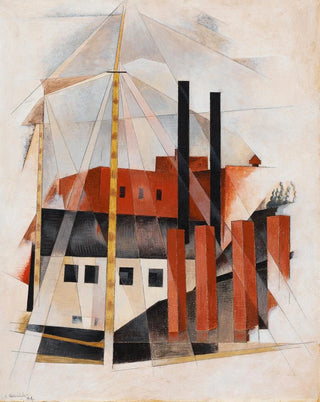Piano Movers' Vacation - Charles Demuth Art print


View from behind

Frame (optional)
In a world where art and everyday life intersect, "Vacances des déménageurs de piano" by Charles Demuth stands out as an iconic work, capturing the very essence of American modernity in the 1920s. This painting, which depicts a moving scene, transcends mere event representation to become a reflection on movement, transition, and the dynamics of urban life. Light and forms intertwine in a composition that invites viewers to ponder the ephemeral nature of life's moments. Through this art print, Demuth's work reveals itself not only as an illustration of a moment but as a true ode to the vibrancy of its era.
Style and uniqueness of the work
Demuth's style is deeply rooted in the modernist movement, and "Vacances des déménageurs de piano" is a perfect illustration of this. The artist employs geometric shapes and vivid colors to create a painting that is both dynamic and harmonious. Clean lines and sharp angles evoke the speed of change, while shades of blue and yellow infuse the scene with vibrant energy. This art print stands out for its ability to capture movement and immediacy, essential characteristics of cubism and futurism. The way Demuth plays with light and shadow enhances the sense of depth and volume, immersing the viewer in a reality where daily life transforms into art.
The artist and his influence
Charles Demuth, a prominent figure in American art, established himself through a unique vision of his time. Influenced by European avant-garde movements, he adapted these inspirations to his American context, creating a style that is entirely his own. His ability to fuse figurative and abstract elements paved the way for many contemporary artists, and his work continues to inspire future generations. Demuth, through his innovative approach, also contributed to redefining the representation of urban life, transforming it into a subject worthy of artistic interest. "Vacances des déménageurs de piano" bears witness to this desire to capture daily life, while elevating it to art.

Matte finish

View from behind

Frame (optional)
In a world where art and everyday life intersect, "Vacances des déménageurs de piano" by Charles Demuth stands out as an iconic work, capturing the very essence of American modernity in the 1920s. This painting, which depicts a moving scene, transcends mere event representation to become a reflection on movement, transition, and the dynamics of urban life. Light and forms intertwine in a composition that invites viewers to ponder the ephemeral nature of life's moments. Through this art print, Demuth's work reveals itself not only as an illustration of a moment but as a true ode to the vibrancy of its era.
Style and uniqueness of the work
Demuth's style is deeply rooted in the modernist movement, and "Vacances des déménageurs de piano" is a perfect illustration of this. The artist employs geometric shapes and vivid colors to create a painting that is both dynamic and harmonious. Clean lines and sharp angles evoke the speed of change, while shades of blue and yellow infuse the scene with vibrant energy. This art print stands out for its ability to capture movement and immediacy, essential characteristics of cubism and futurism. The way Demuth plays with light and shadow enhances the sense of depth and volume, immersing the viewer in a reality where daily life transforms into art.
The artist and his influence
Charles Demuth, a prominent figure in American art, established himself through a unique vision of his time. Influenced by European avant-garde movements, he adapted these inspirations to his American context, creating a style that is entirely his own. His ability to fuse figurative and abstract elements paved the way for many contemporary artists, and his work continues to inspire future generations. Demuth, through his innovative approach, also contributed to redefining the representation of urban life, transforming it into a subject worthy of artistic interest. "Vacances des déménageurs de piano" bears witness to this desire to capture daily life, while elevating it to art.






